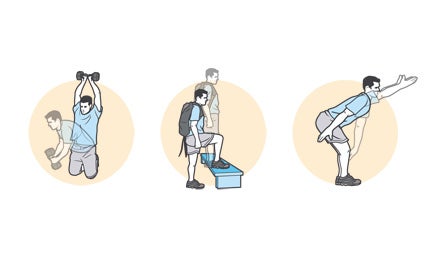Expert Panel: 11 Pro Tips and Backpacking Exercises

'(Illustration by: Supercorn)'
Fitness: Strengthen Your Back
Build your pack-hefting back and core for better on-trail comfort and injury prevention.
Kneeling Halfmoon
Why: Your lower back is especially vulnerable to twists and jerks. Dynamic, rotational strength-builders help stabilize your core for safer pack-lifting and loaded travel on uneven terrain.
How: Start by kneeling on the ground with a 10- to 25-pound weight on your right side (use an iron plate or dumbbell). Bend at the waist, grab the weight with both hands, lift it above your head to full arm extension, and place it to your left side. Reverse the move to complete one rep; do four sets of five reps three times a week.
Loaded Step-Ups
Why: This lower-back exercise helps prevent bad form, like leaning forward, which can cause long-day fatigue. Bonus: This move also builds cardio fitness.
How: Put on a 15- to 20-pound pack. Step straight up onto a 16- to 20-inch bench, fully extending your leg and hip as you stand all the way up. Then, step down and repeat the move, leading with your opposite leg. Start with two 30-minute sessions per week. Go big: Build up to 750 step-ups (375 per leg) in 30 minutes wearing a 40-pound pack.
Low Back Complex
Why: Focused isometrics quickly build strength in pack-hauling muscles.
How: Assume this stance: feet shoulder-width apart, knees slightly bent, leaning forward from the hips. Squeeze your shoulder blades together while pushing your butt back and torso forward. Then, one after the other, hold each of these positions for 20 seconds: arms extended behind you, alongside your torso; arms raised above your head, in-line with your ears; hands pressed into your knees. Do four sets four times a week.
First Aid: Treat Major Wounds
How to identify trouble signs and prevent potentially fatal complications.
If you’re close to a trailhead, treating deeply sliced or scratched skin is straightforward: Get to a hospital, fast. In the wilderness, you have to judge the wound’s severity, clean it aggressively, and watch for infection as you evacuate. Here are tools to help:
1. Diagnose: Evaluate the wound and evacuate if…
- You see underlying structures like bone, tendons, or ligaments beneath the skin.
- Anything (splinters, sand, etc.) is embedded in the flesh and you can’t remove it.
- A resulting scar would be a cosmetic concern (on the face) or impede joint function.
- The victim or wound shows signs of infection or rapid worsening (increased redness, swelling, pain), or at any point after the first 24 hours.
2. Treat: Clean a wound
Scrub or irrigate. Rub abrasions with gauze and water to remove visible debris. Flush deep cuts with at least one liter of high-pressure water using an irrigation syringe (improvise with a hydration bladder and hose). Expect pain; additional bleeding and oozing will help flush the wound.
Use soap. Suds kill invisible bacteria.
Close the skin. If the wound edges don’t touch, tape the skin gently. Don’t overlap skin or close a cut that gapes more than half an inch; leave those open.
Cover it. Apply antibacterial ointment and the cleanest bandage you’ve got.
3. Monitor: Detect and slow infection
Note changes. Pain, redness, and swelling should peak within 24 hours.
Manage it. See signs of worsening? Reclean the cut, replace bandages, and soak the cut several times a day in hot water. Rush evac plans.
4. Evacuate: Determine your method
Walk out: Almost always the best choice. If the victim is capable, get going. Splint to stabilize surrounding tissue.
Ask for rescue: If the victim can’t hike, get help. No cell or emergency beacon? Ideally, one person stays with the victim while two people hike out.
Get Out More: Find Local Beta
Q: How can I take full advantage of my gear store to get the best advice on nearby trails, equipment, and training? – Liz, Indianapolis, IN
A: Outdoor shops are full of experts who want to help you elevate your adventures. Here’s how to tap them for advice:
Ask about trips. Fish for details about an associate’s recent trip, or where other customers have been reporting good conditions. Get specific and take notes.
Get gear advice. Most salespeople have a specialty; if your interests don’t match, get a referral to the store’s expert.
Rent before you buy. Use loaner gear to test-drive big-ticket items. Shop employees also know first-hand about durability; ask for the lowdown on oft-repaired items, then use that insight to guide purchase and maintenance decisions.
Go to clinics. If an event requires registration, sign up ASAP. If an event’s full, volunteer for setup or takedown to score a standing-room seat. No interesting events? Ask the manager how to organize one of your own design.